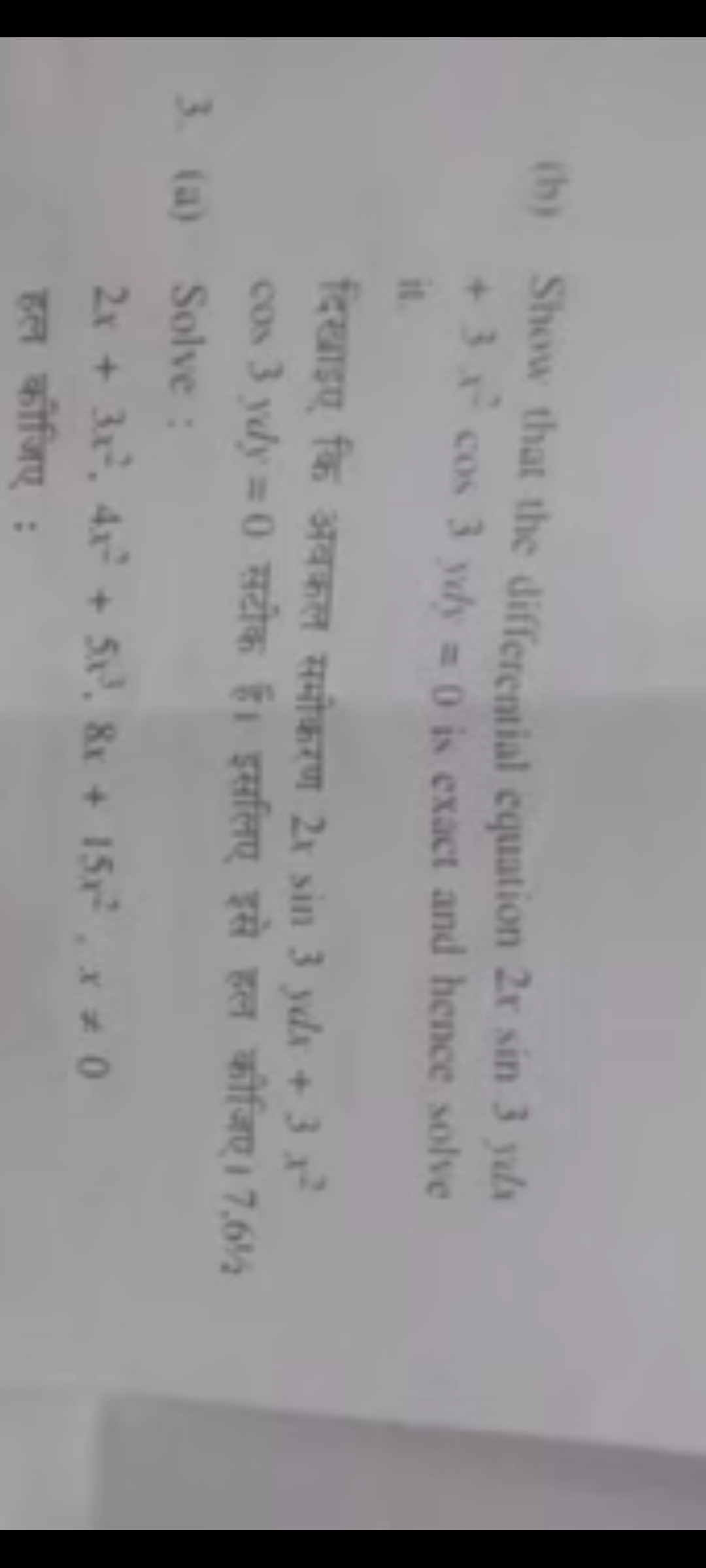Show that the differential equation 2x sin 3y dy + 3x^2 cos 3y = 0 is exact and hence solve.

Understand the Problem
The question asks to show that a given differential equation is exact and then to solve it. The differential equation involves sine and cosine functions.
Answer
The implicit solution is: $$ x^3 \cos(3y) + \frac{1}{2} \sin(3y) + C = 0 $$
Answer for screen readers
The implicit solution of the differential equation is: $$ x^3 \cos(3y) + \frac{1}{2} \sin(3y) + C = 0 $$
Steps to Solve
-
Identify the components of the equation
The given differential equation is:
$$ 2x \sin(3y) dy + 3x^2 \cos(3y) = 0 $$
We can rewrite it as:
$$ M(x, y) = 3x^2 \cos(3y) \quad \text{and} \quad N(x, y) = 2x \sin(3y) $$ -
Check for exactness condition
A differential equation is exact if:
$$ \frac{\partial M}{\partial y} = \frac{\partial N}{\partial x} $$
Calculate:
- For (M):
$$ \frac{\partial M}{\partial y} = -9x^2 \sin(3y) $$ - For (N):
$$ \frac{\partial N}{\partial x} = 2 \sin(3y) $$
Since ( \frac{\partial M}{\partial y} \neq \frac{\partial N}{\partial x} ), the equation is not exact.
-
Differentiate with respect to y and x
Now let's recalculate to check our derivatives correctly:
For ( M ):
$$ \frac{\partial M}{\partial y} = 3x^2 \cdot (-3 \sin(3y)) = -9x^2 \sin(3y) $$
For ( N ):
$$ \frac{\partial N}{\partial x} = 2 \sin(3y) $$
These derivatives do not equalize, indicating that the equation is indeed not exact.
-
Finding an integrating factor
We can often find an integrating factor, but it's not straightforward here; however, let's examine if a function of (y) or (x) can work. In some cases, a function related to (x) or (y) van be used. -
Using potential functions
Alternatively, than solving directly, we look for potential solutions. This implies finding a function (F(x, y)) such that:
$$ \frac{\partial F}{\partial x} = M(x, y) \quad \text{and} \quad \frac{\partial F}{\partial y} = N(x, y) $$ -
Integrating (M)
We can integrate (M(x, y)) with respect to (x):
$$ F(x, y) = \int 3x^2 \cos(3y) dx = x^3 \cos(3y) + g(y) $$
Where (g(y)) is an arbitrary function of (y). -
Differentiating (F) with respect to (y)
Next, we differentiate (F) with respect to (y):
$$ \frac{\partial F}{\partial y} = -3x^3 \sin(3y) + g'(y) $$
Setting this equal to (N(x, y)):
$$ -3x^3 \sin(3y) + g'(y) = 2x \sin(3y) $$ -
Solving for (g(y))
We can equate the remaining terms to find (g'(y)):
$$ g'(y) = 2x \sin(3y) + 3x^3 \sin(3y) $$
This means that: -
Final form of solution
Integrating, we can find an implicit solution.
The implicit solution of the differential equation is: $$ x^3 \cos(3y) + \frac{1}{2} \sin(3y) + C = 0 $$
More Information
This solution represents a family of curves in the x-y plane derived from integrating the non-exact differential equation, revealing the nature of the relationship between (x) and (y).
Tips
- Not verifying exactness properly: Ensure derivatives are calculated correctly.
- Omitting the integration constant: Always remember to include the constant of integration (C) in your solution.
AI-generated content may contain errors. Please verify critical information